Hoifung Poon
MetaScale: Test-Time Scaling with Evolving Meta-Thoughts
Mar 17, 2025Abstract:One critical challenge for large language models (LLMs) for making complex reasoning is their reliance on matching reasoning patterns from training data, instead of proactively selecting the most appropriate cognitive strategy to solve a given task. Existing approaches impose fixed cognitive structures that enhance performance in specific tasks but lack adaptability across diverse scenarios. To address this limitation, we introduce METASCALE, a test-time scaling framework based on meta-thoughts -- adaptive thinking strategies tailored to each task. METASCALE initializes a pool of candidate meta-thoughts, then iteratively selects and evaluates them using a multi-armed bandit algorithm with upper confidence bound selection, guided by a reward model. To further enhance adaptability, a genetic algorithm evolves high-reward meta-thoughts, refining and extending the strategy pool over time. By dynamically proposing and optimizing meta-thoughts at inference time, METASCALE improves both accuracy and generalization across a wide range of tasks. Experimental results demonstrate that MetaScale consistently outperforms standard inference approaches, achieving an 11% performance gain in win rate on Arena-Hard for GPT-4o, surpassing o1-mini by 0.9% under style control. Notably, METASCALE scales more effectively with increasing sampling budgets and produces more structured, expert-level responses.
Semantic-Clipping: Efficient Vision-Language Modeling with Semantic-Guidedd Visual Selection
Mar 14, 2025Abstract:Vision-Language Models (VLMs) leverage aligned visual encoders to transform images into visual tokens, allowing them to be processed similarly to text by the backbone large language model (LLM). This unified input paradigm enables VLMs to excel in vision-language tasks such as visual question answering (VQA). To improve fine-grained visual reasoning, recent advancements in vision-language modeling introduce image cropping techniques that feed all encoded sub-images into the model. However, this approach significantly increases the number of visual tokens, leading to inefficiency and potential distractions for the LLM. To address the generalization challenges of image representation in VLMs, we propose a lightweight, universal framework that seamlessly integrates with existing VLMs to enhance their ability to process finegrained details. Our method leverages textual semantics to identify key visual areas, improving VQA performance without requiring any retraining of the VLM. Additionally, it incorporates textual signals into the visual encoding process, enhancing both efficiency and effectiveness. The proposed method, SEMCLIP, strengthens the visual understanding of a 7B VLM, LLaVA-1.5 by 3.3% on average across 7 benchmarks, and particularly by 5.3% on the challenging detailed understanding benchmark V*.
Boltzmann Attention Sampling for Image Analysis with Small Objects
Mar 04, 2025Abstract:Detecting and segmenting small objects, such as lung nodules and tumor lesions, remains a critical challenge in image analysis. These objects often occupy less than 0.1% of an image, making traditional transformer architectures inefficient and prone to performance degradation due to redundant attention computations on irrelevant regions. Existing sparse attention mechanisms rely on rigid hierarchical structures, which are poorly suited for detecting small, variable, and uncertain object locations. In this paper, we propose BoltzFormer, a novel transformer-based architecture designed to address these challenges through dynamic sparse attention. BoltzFormer identifies and focuses attention on relevant areas by modeling uncertainty using a Boltzmann distribution with an annealing schedule. Initially, a higher temperature allows broader area sampling in early layers, when object location uncertainty is greatest. As the temperature decreases in later layers, attention becomes more focused, enhancing efficiency and accuracy. BoltzFormer seamlessly integrates into existing transformer architectures via a modular Boltzmann attention sampling mechanism. Comprehensive evaluations on benchmark datasets demonstrate that BoltzFormer significantly improves segmentation performance for small objects while reducing attention computation by an order of magnitude compared to previous state-of-the-art methods.
Med-RLVR: Emerging Medical Reasoning from a 3B base model via reinforcement Learning
Feb 27, 2025Abstract:Reinforcement learning from verifiable rewards (RLVR) has recently gained attention for its ability to elicit self-evolved reasoning capabilitie from base language models without explicit reasoning supervisions, as demonstrated by DeepSeek-R1. While prior work on RLVR has primarily focused on mathematical and coding domains, its applicability to other tasks and domains remains unexplored. In this work, we investigate whether medical reasoning can emerge from RLVR. We introduce Med-RLVR as an initial study of RLVR in the medical domain leveraging medical multiple-choice question answering (MCQA) data as verifiable labels. Our results demonstrate that RLVR is not only effective for math and coding but also extends successfully to medical question answering. Notably, Med-RLVR achieves performance comparable to traditional supervised fine-tuning (SFT) on in-distribution tasks while significantly improving out-of-distribution generalization, with an 8-point accuracy gain. Further analysis of training dynamics reveals that, with no explicit reasoning supervision, reasoning emerges from the 3B-parameter base model. These findings underscore the potential of RLVR in domains beyond math and coding, opening new avenues for its application in knowledge-intensive fields such as medicine.
Universal Abstraction: Harnessing Frontier Models to Structure Real-World Data at Scale
Feb 02, 2025



Abstract:The vast majority of real-world patient information resides in unstructured clinical text, and the process of medical abstraction seeks to extract and normalize structured information from this unstructured input. However, traditional medical abstraction methods can require significant manual efforts that can include crafting rules or annotating training labels, limiting scalability. In this paper, we propose UniMedAbstractor (UMA), a zero-shot medical abstraction framework leveraging Large Language Models (LLMs) through a modular and customizable prompt template. We refer to our approach as universal abstraction as it can quickly scale to new attributes through its universal prompt template without curating attribute-specific training labels or rules. We evaluate UMA for oncology applications, focusing on fifteen key attributes representing the cancer patient journey, from short-context attributes (e.g., performance status, treatment) to complex long-context attributes requiring longitudinal reasoning (e.g., tumor site, histology, TNM staging). Experiments on real-world data show UMA's strong performance and generalizability. Compared to supervised and heuristic baselines, UMA with GPT-4o achieves on average an absolute 2-point F1/accuracy improvement for both short-context and long-context attribute abstraction. For pathologic T staging, UMA even outperforms the supervised model by 20 points in accuracy.
A Perspective for Adapting Generalist AI to Specialized Medical AI Applications and Their Challenges
Oct 28, 2024
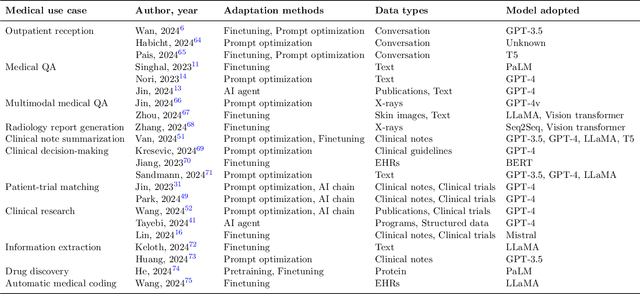

Abstract:The integration of Large Language Models (LLMs) into medical applications has sparked widespread interest across the healthcare industry, from drug discovery and development to clinical decision support, assisting telemedicine, medical devices, and healthcare insurance applications. This perspective paper aims to discuss the inner workings of building LLM-powered medical AI applications and introduces a comprehensive framework for their development. We review existing literature and outline the unique challenges of applying LLMs in specialized medical contexts. Additionally, we introduce a three-step framework to organize medical LLM research activities: 1) Modeling: breaking down complex medical workflows into manageable steps for developing medical-specific models; 2) Optimization: optimizing the model performance with crafted prompts and integrating external knowledge and tools, and 3) System engineering: decomposing complex tasks into subtasks and leveraging human expertise for building medical AI applications. Furthermore, we offer a detailed use case playbook that describes various LLM-powered medical AI applications, such as optimizing clinical trial design, enhancing clinical decision support, and advancing medical imaging analysis. Finally, we discuss various challenges and considerations for building medical AI applications with LLMs, such as handling hallucination issues, data ownership and compliance, privacy, intellectual property considerations, compute cost, sustainability issues, and responsible AI requirements.
MedImageInsight: An Open-Source Embedding Model for General Domain Medical Imaging
Oct 09, 2024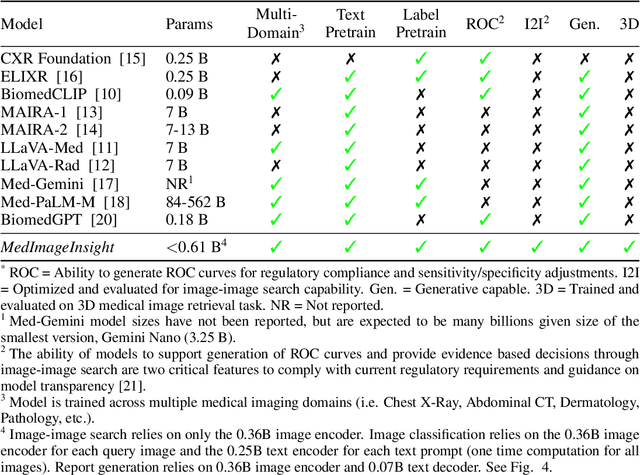
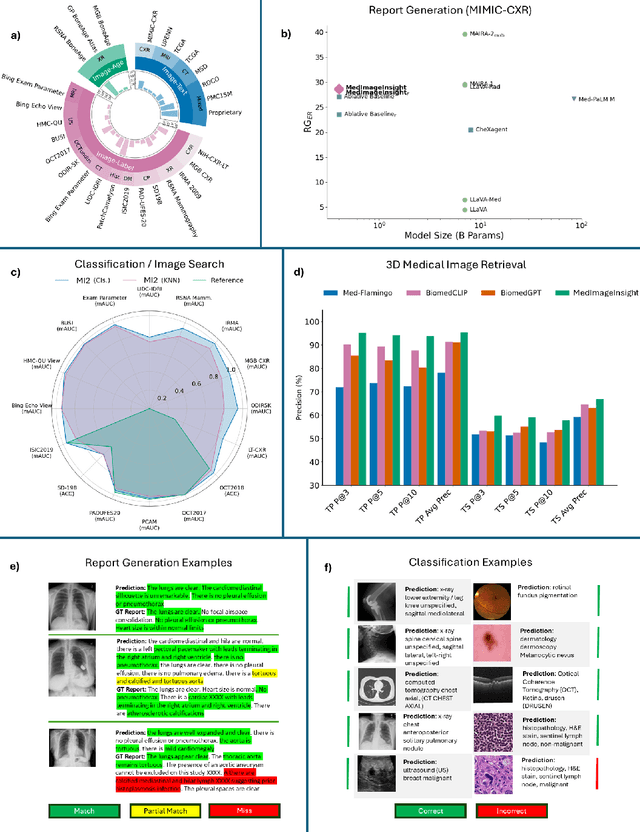
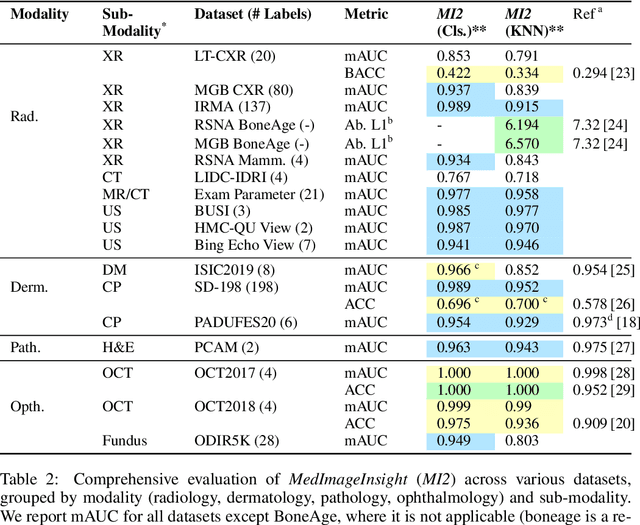
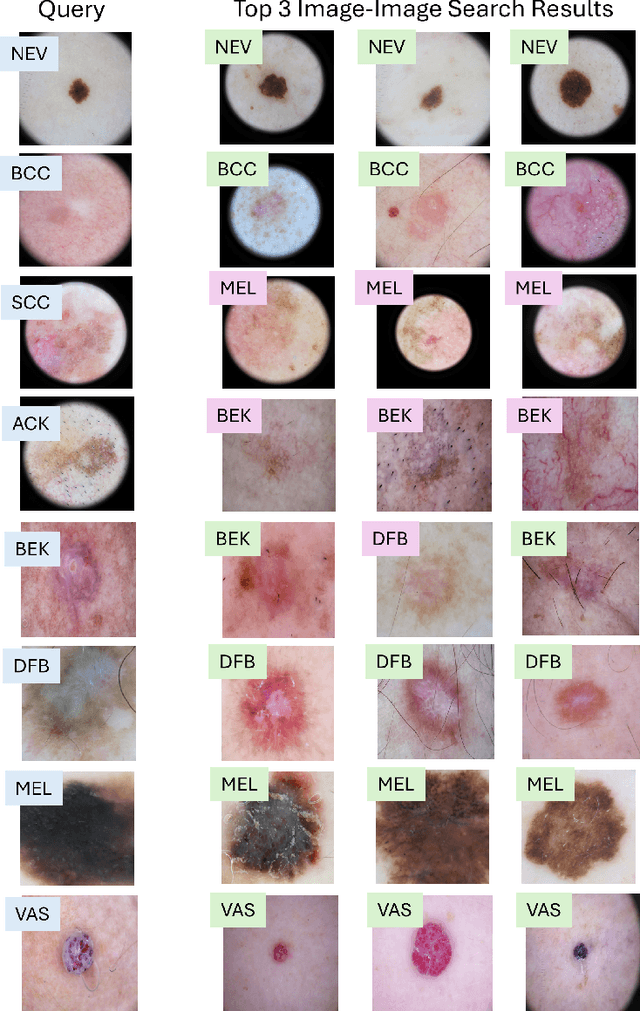
Abstract:In this work, we present MedImageInsight, an open-source medical imaging embedding model. MedImageInsight is trained on medical images with associated text and labels across a diverse collection of domains, including X-Ray, CT, MRI, dermoscopy, OCT, fundus photography, ultrasound, histopathology, and mammography. Rigorous evaluations demonstrate MedImageInsight's ability to achieve state-of-the-art (SOTA) or human expert level performance across classification, image-image search, and fine-tuning tasks. Specifically, on public datasets, MedImageInsight achieves SOTA in CT 3D medical image retrieval, as well as SOTA in disease classification and search for chest X-ray, dermatology, and OCT imaging. Furthermore, MedImageInsight achieves human expert performance in bone age estimation (on both public and partner data), as well as AUC above 0.9 in most other domains. When paired with a text decoder, MedImageInsight achieves near SOTA level single image report findings generation with less than 10\% the parameters of other models. Compared to fine-tuning GPT-4o with only MIMIC-CXR data for the same task, MedImageInsight outperforms in clinical metrics, but underperforms on lexical metrics where GPT-4o sets a new SOTA. Importantly for regulatory purposes, MedImageInsight can generate ROC curves, adjust sensitivity and specificity based on clinical need, and provide evidence-based decision support through image-image search (which can also enable retrieval augmented generation). In an independent clinical evaluation of image-image search in chest X-ray, MedImageInsight outperformed every other publicly available foundation model evaluated by large margins (over 6 points AUC), and significantly outperformed other models in terms of AI fairness (across age and gender). We hope releasing MedImageInsight will help enhance collective progress in medical imaging AI research and development.
From Introspection to Best Practices: Principled Analysis of Demonstrations in Multimodal In-Context Learning
Jul 01, 2024Abstract:Motivated by in-context learning (ICL) capabilities of Large Language models (LLMs), multimodal LLMs with additional visual modality are also exhibited with similar ICL abilities when multiple image-text pairs are provided as demonstrations. However, relatively less work has been done to investigate the principles behind how and why multimodal ICL works. We conduct a systematic and principled evaluation of multimodal ICL for models of different scales on a broad spectrum of new yet critical tasks. Through perturbations over different modality information, we show that modalities matter differently across tasks in multimodal ICL. Considering such modality impact, we further utilize modality-driven demonstration strategies to boost ICL performance. We also identify that demonstration selection is closely related to the models' ability to capture task inductive biases from multimodal ICL. Our principled analysis provides a comprehensive way of understanding the role of demonstrations in multimodal in-context learning, and sheds light on effectively improving multimodal ICL on a wide range of tasks even if those tasks are not seen in or even contradict pretraining data.
mDPO: Conditional Preference Optimization for Multimodal Large Language Models
Jun 17, 2024



Abstract:Direct preference optimization (DPO) has shown to be an effective method for large language model (LLM) alignment. Recent works have attempted to apply DPO to multimodal scenarios but have found it challenging to achieve consistent improvement. Through a comparative experiment, we identify the unconditional preference problem in multimodal preference optimization, where the model overlooks the image condition. To address this problem, we propose mDPO, a multimodal DPO objective that prevents the over-prioritization of language-only preferences by also optimizing image preference. Moreover, we introduce a reward anchor that forces the reward to be positive for chosen responses, thereby avoiding the decrease in their likelihood -- an intrinsic problem of relative preference optimization. Experiments on two multimodal LLMs of different sizes and three widely used benchmarks demonstrate that mDPO effectively addresses the unconditional preference problem in multimodal preference optimization and significantly improves model performance, particularly in reducing hallucination.
MuirBench: A Comprehensive Benchmark for Robust Multi-image Understanding
Jun 13, 2024



Abstract:We introduce MuirBench, a comprehensive benchmark that focuses on robust multi-image understanding capabilities of multimodal LLMs. MuirBench consists of 12 diverse multi-image tasks (e.g., scene understanding, ordering) that involve 10 categories of multi-image relations (e.g., multiview, temporal relations). Comprising 11,264 images and 2,600 multiple-choice questions, MuirBench is created in a pairwise manner, where each standard instance is paired with an unanswerable variant that has minimal semantic differences, in order for a reliable assessment. Evaluated upon 20 recent multi-modal LLMs, our results reveal that even the best-performing models like GPT-4o and Gemini Pro find it challenging to solve MuirBench, achieving 68.0% and 49.3% in accuracy. Open-source multimodal LLMs trained on single images can hardly generalize to multi-image questions, hovering below 33.3% in accuracy. These results highlight the importance of MuirBench in encouraging the community to develop multimodal LLMs that can look beyond a single image, suggesting potential pathways for future improvements.
 Add to Chrome
Add to Chrome Add to Firefox
Add to Firefox Add to Edge
Add to Edge